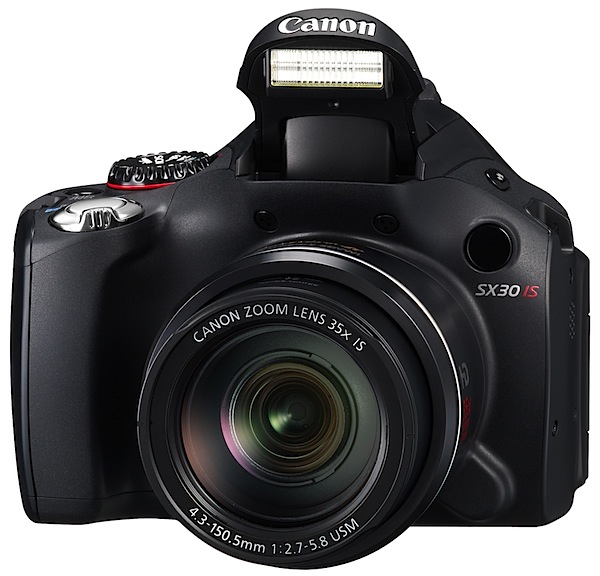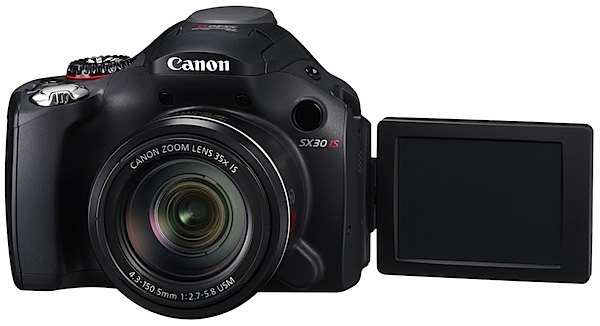They?ve got to be kidding!
No…. It?s true. The Canon PowerShot SX30 IS has a 35x zoom lens! Stabilised and with a reasonably fast f2.7 maximum aperture.

I had an early preview of this gem a few months before its official release and was stunned at the range of the hyper zoom. Then, more recently, spent a day with one, chasing cars, boats and choppers. At one stage I was sitting in the back of a limo, shooting another 20 metres behind and was surprised not only at the tele stretch but at the way the auto focus and stabiliser managed things, even though both cars were doing a bit of bumping around.

This latest fixed lens digicam from Canon shows how far the game has come. The 35x zoom would be almost useless but for the improvements Canon has made to the auto focus, equivalent to approximately 4.5 f stops in terms of shutter speed. As I found out!

Canon Powershot SX30 Features
But back to the show.
I?m a bit sad that the CCD is only 11cm in size but welcome the 14.1 megapixels of shooting power. Maximum image size is 4320×3240 pixels, leading to a 37×27cm print.
Movies? Not so hot, with a maximum res of only 1280×720 pixels at 30 fps. It?s a shame Canon didn?t make the leap to 1920×1080 in this model. The good news is that auto focus, exposure and the stabiliser are fully in play while shooting video.
Aerial shot made at ISO 1600 setting: noise is visible but at least I could use a fast shutter speed for shooting out of the chopper. Lens: f7.1. Shutter: 1/1250 second.
You get the usual array of exposure options: auto, Program AE, aperture and shutter priority as well as manual plus a group of scene modes directly accessible from the mode dial. Enter the viewfinder menu and you can find more: fish-eye effect, miniature effect, fireworks etc.
The rear LCD screen is highly mobile: laterally 175 degrees; vertically 270 degrees.
A nice trick is a framing assistant which is handy when you are out at full zoom: touch the button and the scene momentarily widens out so you can find where you are! Unfortunately, I found my right gripping thumb kept firing the framing assistant, when I didn?t need it.
Full wider and full tele: this is how a 35x zoom performs. Even I had to admit I was surprised at the amazing stretch of the camera?s zoom. Both of these very sharp shots were made with the camera tripod-mounted.
Handling: thanks to the hunky speed grip you can hold the camera steadily with one hand for stills and movie shooting. There is a slight penalty with the camera?s 600 grams weight, so you find you won?t be able to hold it up for extended periods.
ISO Tests
For me, all settings up to ISO 800 could be used for general photography: clean image, low noise, excellent definition.
The top ISO ? 1600 ? was the first to show any signs of noise: but it is a useable setting when you need it.
Startup Time
A little on the slow side, the camera took three seconds after power up to shoot the first shot; follow-ons came in at about two seconds each.
Distortion
Aside from its amazing zoom stretch, this lens is quite a performer, with no sign of any distortion at the wide or the tele end of the zoom. Terrific!
Comment
Quality: the camera showed it could handle wide contrast ranges, with excellent colour and very good resolution.
Why you?d buy the G11: love that 35x zoom; great stabiliser.
Why you wouldn?t: a little heavy, thanks to the big glass out front; not Full HD video.
A rare, powerful piece of kit. I could find little fault, except that the power button could have been picked out in white to make it more visible.
And… the card/battery compartment is super hard to open.
Canon Powershot SX30 IS Specifications
Image Sensor: 14.1 million effective pixels.
Metering: Evaluative, centre-weighted average; spot.
Sensor Size: 11mm CCD.
Lens: f2.7-5.8/4.3-150.5mm (28-840mm as 35 SLR equivalent).
Shutter Speed: 1 to 1/3200 second.
Continuous Shooting: 0.6 to 1.3 fps.
Memory: SD, SDHC, MMC, MMCplus, HC MMCplus, HC MMCplus cards.
Image Sizes (pixels): 4320×3240 to 640×480. Movies: 1280×720, 640×480, 320×240 at 30 fps.
File Formats: JPEG, RAW, Motion JPEG.
ISO Sensitivity: Auto, 80 to 1600.
Turret viewfinder and rear 6.9cm LCD screen (230,000 pixels).
Interface: USB 2.0, AV, HDMI mini, DC input.
Power: Rechargeable lithium ion battery.
Dimensions: 122.9×107.7×92.4 WHDmm.
Weight: Approx. 552 g (body only).
Price: Get a price on the Canon SX30IS at Amazon where it is currently 14% off.
Post from: Digital Photography School





















